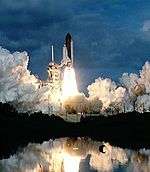TDRS-6
 TDRS-F being deployed from Endeavour | |
| Mission type | Communication |
|---|---|
| Operator | NASA |
| COSPAR ID | 1993-003B |
| Mission duration |
10 years (planned) 16+ years (achieved) |
| Spacecraft properties | |
| Manufacturer | TRW |
| Launch mass | 3,180 kilograms (7,010 lb)[1] |
| Start of mission | |
| Launch date | 13 January 1993, 13:59:30 UTC |
| Rocket |
Space Shuttle Endeavour STS-54 / IUS |
| Launch site | Kennedy LC-39B |
| Orbital parameters | |
| Reference system | Geocentric |
| Regime | Geostationary |
| Longitude |
46° West (1994-1996) 47° West (1996-2005) 174° West (2005—) |
| Perigee | 35,773 kilometers (22,228 mi) |
| Apogee | 35,787 kilometers (22,237 mi) |
| Inclination | 8.74 degrees |
TDRS-6, known before launch as TDRS-F, is an American communications satellite which is operated by NASA as part of the Tracking and Data Relay Satellite System. It was constructed by TRW, and is based on a custom satellite bus which was used for all seven first generation TDRS satellites.[2]
History

TDRS-F was deployed from Space Shuttle Endeavour during the STS-54 mission in 1993. Endeavour was launched from Launch Complex 39B at the Kennedy Space Center, at 13:59:30 GMT on 13 January 1993.[3] TDRS-F was deployed from Endeavour around six hours after launch, and was raised to geosynchronous orbit by means of an Inertial Upper Stage.[3]
Deployment
The two-stage solid-propellent Inertial Upper Stage made two burns. The first stage burn occurred shortly after deployment from Endeavour, and placed the satellite into a geosynchronous transfer orbit. At 02:26 GMT on 14 January it reached apogee, and the second stage fired, placing TDRS-F into geosynchronous orbit.[4] At this point it received its operational designation, TDRS-6.
Operation
In 1994, it was placed at a longitude 46 degrees west of the Greenwich Meridian, to serve as an on-orbit spare.[5] In 1996, it was moved to 47° West, where it remained until 2005, when it was repositioned to 174° West,[5] where, as of August 2009, it was used to provide communications with spacecraft in Earth orbit, including Space Shuttles and the International Space Station.
References
- ↑ "UCS Satellite Database". Union of Concerned Scientists. 2009-07-01. Retrieved 2009-08-09.
- ↑ Krebs, Gunter. "TDRS 1, 2, 3, 4, 5, 6". Gunter's Space Page. Retrieved 2009-08-09.
- 1 2 McDowell, Jonathan. "Launch Log". Jonathan's Space Page. Retrieved 2009-08-09.
- ↑ McDowell, Jonathan. "Index". Geostationary Orbit Catalog. Jonathan's Space Page. Retrieved 2009-08-09.
- 1 2 "TDRS 6". TSE. Retrieved 2009-08-09.
